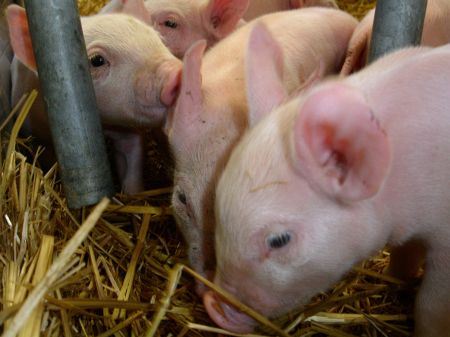Castration of male piglets is carried out practically throughout the EU within the first week of life without eliminating pain. The Austrian Animal Protection Act (2005) also legalizes this type of castration. The possible alternatives to this solution, which is controversial in terms of animal welfare, ethically and emotionally, are currently not relevant or not competitive in practice due to their additional technical or financial effort (halothane anesthesia (expense), injection of an anesthetic preparation or local anesthetic (only possible by a veterinarian); use of painkillers ( high costs), boar fattening (little tested, sexual odor and possibly uneconomical, consumers?), immunocastration (costs, approval, ethics, (male) consumers?).
The requirements for a correspondingly practical solution are:
- Can also be carried out quickly and easily by the farmer
- As stress-free and pain-free as possible for the animal
- Animal welfare friendly
- Ethically and morally justifiable
- Low cost
- Conformity with the existing legal situation (e.g. Veterinary Drug Control Act)
In a trial at the HBLFA Raumberg-Gumpenstein, a variant for castrating male piglets is to be tested for its practical suitability and its effects on the cortisol content in the test subjects' blood.
In the method to be checked, which can also be carried out by a farmer, a local anesthetic should be used in a repurposed application method after local freezing of the testicular area with a spray and subsequent castration.
The local anesthetic (injectable LA, preferably with a barrier body) should be injected into the castration wound in spray form. In terms of pharmaceutical law, this is a reclassification, which results in a waiting period of 28 days for edible tissues, which is observed in this experiment anyway. In practice, this waiting time is not a problem either.
Experimental plan castration group division
Group A: Control group: male piglets: local freezing and blood sampling, none
Group B: Group castration conventional: castration like lege artis, blood sample collection
Group C: Group Castration Experiment: Castration under icing and spray local anesthesia, blood sample collection
Group D: Group of female piglets: only behavioral observations using a checklist
Number of piglets per group: 12 (12x3=36)
Timing (h) Blood sample collection: -0.5, +0.5, 4, 12 (4x36=144)
In addition to determining the course of cortisol, surveys of the piglets' behavior are carried out using a checklist at 10-minute intervals over a period of 12 hours post-op.
The experiment is an animal experiment (taking blood samples from piglets to determine cortisol) and is carried out on animals from the HBLFA Raumberg-Gumpenstein animal population. The HBLFA Raumberg-Gumpenstein is a legitimate animal testing facility according to a valid decision from the responsible authority (Office of the Styria State Government).
A corresponding application for approval of the present animal experiment (§9 TVG) is submitted by Dr. J. Gasteiner, head of the animal testing facilities at HBLFA Raumberg-Gumpenstein.
The animal experiment was carried out on January 23, 2007 by the responsible office of Stmk. State government approved.
Summary - Results
According to current Austrian animal protection law, surgical castration of piglets may be carried out in the first 7 days of life without eliminating pain. In an experiment, a variant for eliminating pain during surgical castration on 5-day-old piglets (experimental group) was compared to castration without eliminating pain (positive control group) and to the negative control group without castration (n = 84). In the animals of the control group, the skin in the scrotum area was anesthetized using a cryo-method before the skin incisions were made and after the testicles were removed, a local anesthetic with a barrier body was applied in spray form into the wound cavity and onto the stump of the spermatic cord.
The results of the behavioral studies showed with regard to the "suckling" parameter that the piglets castrated using the method described in the first 6 hours after castr. significantly more frequently and longer (p
The course of the cortisol concentration in the blood differed significantly in the piglets of the experimental group (p
The method proved to be simple in practice and requires little time, meaning it can also be carried out by a knowledgeable person (animal owner). The material costs when using the method are 25 cents per piglet.
A disadvantage of the method is that the spermatic cord is not anesthetized and that removing the spermatic cord remains painful. This problem will also be solved in a follow-up project. According to the current legal situation, the local anesthetic used in the present study may not be supplied to farmers. The presented variant for reducing pain during surgical castration through cryotreatment as well as the postoperative pain treatment with a local anesthetic with a barrier body in spray form represents a significant improvement for the piglets in terms of the painfulness of the procedure. The method is cost-effective, practical, but can also be improved and it can be used by be carried out by a trained person.
Internal project partners:
Ofner-Schröck Elfriede, Dipl.Ing. Dr.
Steinwidder Andreas, Priv. Doz. Dr. DI
External cooperation partners:
Further information about piglet castration can also be found at the Sanftkast II project .







